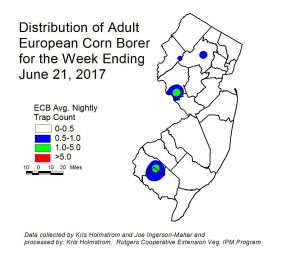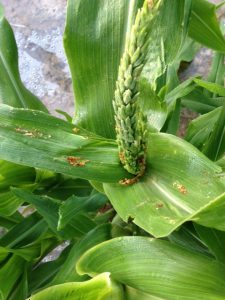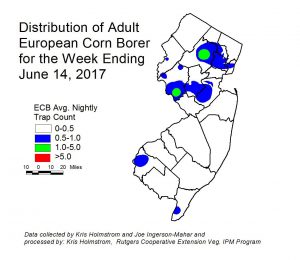- Bacterial leaf spot has been reported in pepper and cucumber.
- Cucurbit downy mildew has been confirmed on cucumber in New Jersey.
- Basil downy mildew has been reported in central New Jersey.
- There have been no new reports of Late blight on tomato or potato in the past week.
Vegetable Crops Edition
Seasonal updates and alerts on insects, diseases, and weeds impacting vegetable crops. New Jersey Commercial Vegetable Production Recommendations updates between annual publication issues are included.
Subscriptions are available via EMAIL and RSS.
Quick Links:
 NJ Commercial Vegetable Production Recommendations
NJ Commercial Vegetable Production Recommendations
 Rutgers Weather Forecasting - Meteorological Information important to commercial agriculture.
Rutgers Weather Forecasting - Meteorological Information important to commercial agriculture.
Vegetable Disease Update – 6/28/17
Cucurbit Downy Mildew ALERT – 6/28/17
Cucurbit downy mildew was confirmed on cucumber in southern New Jersey (Salem County) today. This is the first report of CDM in New Jersey this growing season. All cucumber growers are encouraged to add downy mildew specific fungicides to their weekly maintenance spray programs. All growers should scout cucumber plantings as well as all other cucurbit crops for symptoms. CDM was reported late last week in on cucumber in Maryland (Dorchester County). To track the progress of cucurbit downy mildew in the US through the CDMpipe website through NCSU please click here.
Veg IPM Update: Week Ending 6/28/17
Sweet Corn
European corn borer (ECB) catches have dropped to nearly nothing, and no map will appear in this edition. Feeding in NJ sweet corn plantings is highly variable, with some plantings exceeding 40%, but these occurrences are generally where there were higher moth catches during the first flight. Feeding overall is lower than expected for the first generation. Check 5 plants each in 10 random locations for a 50 plant sample. Look for “shot-hole” injury, and consider treating when the number of infested plants in a 50 plant sample exceeds 12%. As infested plants proceed to the pre-tassel stage, live larvae and damage may be found in the emerging tassels. Once plants hit full tassel, ECB larvae will move downward on the stalk and re-enter the plant near the area where ears are forming. This can result in direct injury to the ear. Growers should consider an insecticide application at the full tassel stage to target ECB larvae as they migrate downward. This application can eliminate larvae that have escaped any earlier insecticide applications. [Read more…]
Veg IPM Update: Week Ending 6/21/17
Sweet Corn
 European corn borer (ECB) catches remain low generally, with a few remaining hot spots in southern Hunterdon County and on the Cumberland-Salem border (see ECB map). Feeding in NJ sweet corn plantings has risen, with some plantings exceeding 40%. Check 5 plants each in 10 random locations for a 50 plant sample. Look for “shot-hole” injury, and consider treating when the number of infested plants in a 50 plant sample exceeds 12%. As infested plants proceed to the pre-tassel stage, live larvae and damage may be found in the emerging tassels (see bottom photo at right). Once plants hit full tassel, ECB larvae will move downward on the stalk and re-enter the plant near the area where ears are forming. This can result in direct injury to the ear. Growers should consider an insecticide application at the full tassel stage to target ECB larvae as they migrate downward. This application can eliminate larvae that have escaped
European corn borer (ECB) catches remain low generally, with a few remaining hot spots in southern Hunterdon County and on the Cumberland-Salem border (see ECB map). Feeding in NJ sweet corn plantings has risen, with some plantings exceeding 40%. Check 5 plants each in 10 random locations for a 50 plant sample. Look for “shot-hole” injury, and consider treating when the number of infested plants in a 50 plant sample exceeds 12%. As infested plants proceed to the pre-tassel stage, live larvae and damage may be found in the emerging tassels (see bottom photo at right). Once plants hit full tassel, ECB larvae will move downward on the stalk and re-enter the plant near the area where ears are forming. This can result in direct injury to the ear. Growers should consider an insecticide application at the full tassel stage to target ECB larvae as they migrate downward. This application can eliminate larvae that have escaped any earlier insecticide applications. [Read more…]
any earlier insecticide applications. [Read more…]
Veg IPM Update: Week Ending 6/14/17
Sweet Corn
 European corn borer (ECB) catches have stabilized, with significant catches remaining in central Morris County and in southern Hunterdon County (see ECB map). Feeding in NJ sweet corn plantings is increasing in occurrence, although severity of individual infestations has not risen dramatically. Overall, activity is lower than expected this year, likely due to adverse weather conditions. Feeding rates in the 20% range are common. Check 5 plants each in 10 random locations for a 50 plant sample. Look for “shot-hole” injury, and consider treating when the number of infested plants in a 50 plant sample exceeds 12%. As infested plants proceed to the pre-tassel stage, live larvae and damage may be found in the emerging tassels (see bottom photo at right). Once plants hit full tassel, ECB larvae will move downward on the stalk and re-enter the plant near the area where ears are forming. This can result in direct injury to the ear. Growers should consider an insecticide application at the full tassel stage to target ECB larvae as they migrate downward. This application can eliminate larvae that have escaped
European corn borer (ECB) catches have stabilized, with significant catches remaining in central Morris County and in southern Hunterdon County (see ECB map). Feeding in NJ sweet corn plantings is increasing in occurrence, although severity of individual infestations has not risen dramatically. Overall, activity is lower than expected this year, likely due to adverse weather conditions. Feeding rates in the 20% range are common. Check 5 plants each in 10 random locations for a 50 plant sample. Look for “shot-hole” injury, and consider treating when the number of infested plants in a 50 plant sample exceeds 12%. As infested plants proceed to the pre-tassel stage, live larvae and damage may be found in the emerging tassels (see bottom photo at right). Once plants hit full tassel, ECB larvae will move downward on the stalk and re-enter the plant near the area where ears are forming. This can result in direct injury to the ear. Growers should consider an insecticide application at the full tassel stage to target ECB larvae as they migrate downward. This application can eliminate larvae that have escaped any earlier insecticide applications. [Read more…]
any earlier insecticide applications. [Read more…]
Vegetable Disease Update – 6/14/17
- The extremely hot weather we are currently experiencing is likely to spur on Phytophthora blight development in pepper, tomato, cucurbit, and eggplant crops. For more on controlling Phytophthora blight click here.
- Suncald has been reported in newly transplanted peppers in south Jersey. Transplants laying against or on black plastic mulch; or in even some cases where the sun reflects off the mulch or soil, can cause sunburn on stems of plants that haven’t fully hardened off. Avoid transplanting on extremely hot and sunny days.
- Bacterial leaf spot was reported in tomato this past week.
- Downy mildew has been reported as far north as Northern Florida on multiple cucurbit crops and on cucumber in South Carolina and North Carolina to date.
- There have been no new reports of Late blight in the past week.
